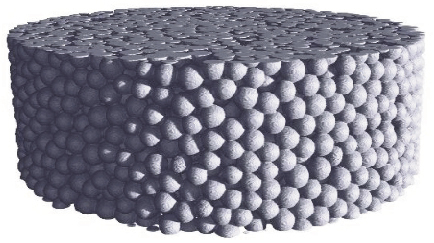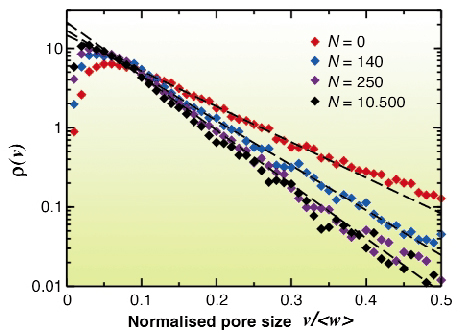- Home
- Users & Science
- Scientific Documentation
- ESRF Highlights
- ESRF Highlights 2003
- X-ray Imaging
- Analysis of Granular Compaction by X-ray Microtomography
Analysis of Granular Compaction by X-ray Microtomography
The slow dynamics of out-of-equilibrium systems remains a source of debate. Even though granular media are not thermal systems, their relaxation under weak mechanical perturbations have a formal analogy with the slow dynamics of out-of-equilibrium thermal systems. This analogy is based on the idea that the geometry of the system is more important than any other parameter as the type of driving energy or the mechanical interaction between particles. Slow compaction of shaken granular packing - the progressive increase of the packing fraction - appears to provide fundamental information for the investigation of the above analogy. The study presented here used X-ray microtomography to characterise the microstructure of granular packing undergoing compaction.
We used an experimental setup simular to previous ones [1,2]: 200-400 µm diameter glass beads were poured to a height about 80 mm in an 8 mm inner-diameter glass cylinder. This was vertically shaken for a given number N of sinusoidal excitations at a frequency of 70 Hz. Microtomographical analysis at beamline ID19 was then used to reconstruct granular packings (Figure 135). The intensity of the vibration is characterised by ![]() , the maximal applied acceleration normalised by gravity. The pixel size is 4.91 µm and the spatial resolution is 10 µm.
, the maximal applied acceleration normalised by gravity. The pixel size is 4.91 µm and the spatial resolution is 10 µm.
 |
|
Fig. 135: Part of a reconstructed packing. |
By comparison with the small decrease in the average distance between grains accompanying compaction, evidence of a transformation in the packing microstructure appears to be better described by the size of the interstitial voids. Following previous work [3] we defined a pore size via the Voronoi tessellation and normalised it by the mean volume of a grain <w>. Figure 136 presents the evolution of the pore volume distribution for ![]() = 3.0 at different stages of the compaction. An exponential decay law is found for the distribution of the voids, at least for the pores larger than octahedral pores. The exponential shape persists during the compaction of the packing yet with a reduction of the tail. These results were found to be very close to results of numerical simulations [3] where there were only geometric constraints in a packing of identical hard spheres. This agreement emphasises the fundamental importance of the steric constraint between the grains that rules the local rearrangements of grains allowed by the shaking energy.
= 3.0 at different stages of the compaction. An exponential decay law is found for the distribution of the voids, at least for the pores larger than octahedral pores. The exponential shape persists during the compaction of the packing yet with a reduction of the tail. These results were found to be very close to results of numerical simulations [3] where there were only geometric constraints in a packing of identical hard spheres. This agreement emphasises the fundamental importance of the steric constraint between the grains that rules the local rearrangements of grains allowed by the shaking energy.
 |
|
Fig. 136: Evolution of the volume distribution of the pores for |
This study should be completed by considering individual grain motion at each degree of excitation in order to tackle the problem of diffusivity in granular media.
References
[1] B. Knight, C.G. Fandrich, C.N. Lau, H.M. Jaeger, and S.R. Nagel, Phys. Rev. E 51, 3957 (1995).
[2] P. Philippe and D. Bideau, Europhys. Lett. 60, 677 (2002).
[3] P. Philippe and D. Bideau, Phys. Rev. E 63, 051304 (2001).
Principal Publication and Authors
P. Richard (a), P. Philippe (b), F. Barbe (c), S. Bourlès (a), X. Thibault (d) and D. Bideau (a), Phys. Rev E 68, 020301(R) (2003).
(a) Université Rennes I CNRS, Rennes (France)
(b) ESPCI CNRS, Paris (France)
(c) INSA Rouen CNRS, Rouen (France)
(d) ESRF



